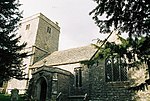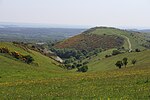Ridgeway Hill
Hills of Dorset

Ridgeway Hill, also referred to as Grange Hill or Steeple Hill, is the third highest point of the Purbeck Hills in the county of Dorset standing at 199 metres (653 ft), is one of the only hills with a prominence of over a hundred metres, HuMPs, in the county. Near the top of the hill is an 18th-century folly known as Grange Arch, built by the former owner of Creech Grange, Denis Bond. On the eastern spur of the hill is Stonehill Down which is now a nature reserve. There are also good views of Swyre Head on the Jurassic Coast.
Excerpt from the Wikipedia article Ridgeway Hill (License: CC BY-SA 3.0, Authors, Images).Ridgeway Hill
Grange Hill,
Geographical coordinates (GPS) Address Nearby Places Show on map
Geographical coordinates (GPS)
| Latitude | Longitude |
|---|---|
| N 50.6358 ° | E -2.1221 ° |
Address
Grange Arch
Grange Hill
BH20 5DF , Steeple with Tyneham
England, United Kingdom
Open on Google Maps










